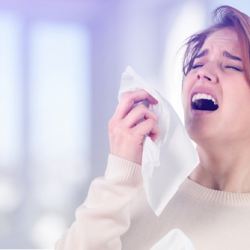Not only is spring a beautiful time of year for those of us in the temperate zones, but it is also a financially lucrative period for companies in the business of making tissues, antihistamines, decongestants and other items to help deal with allergic rhinitis, better known as hay fever. But for people with the condition, spring is not so beautiful. While most sufferers develop allergic rhinitis in childhood, it can appear in adulthood as well.
Most commonly, pollen from trees and/or grasses are the culprits in causing those sneezing fits, runny eyes, and/or congested nasal passages, and spores of various molds can also provoke symptoms. Early spring bloomers such as ash, birch, cedar, elm, maple and locust trees, as well as many grass species provide the triggers for such symptoms. According to the CDC, about 20 million people have been diagnosed with hay fever in the US in the past year, representing about 8.2 percent of the population.
Hay fever is a dysfunction of the immune system, says the American Academy of Allergy Asthma and Immunology (AAAA). A sufferer's immune system mistakes a harmless foreign object (e.g., tree pollen) for a dangerous invader and releases "histamine and chemical mediators" that cause the eye, nose, and sometimes skin and mouth symptoms.
What can you do about it? Well, to start with, you can monitor how likely it is in your area that the amount of pollen in the air will or won't be high by checking the website of the National Allergy Bureau (NAB) or listening to your local news station. The NAB, a part of the AAAA, monitors pollen counts using a definitely low-tech method. They leave a monitor (e.g. a glass rod) coated with a sticky substance exposed to the air in a given area. Airborne pollen and mold spores (another allergen) stick to the monitor. After 24 hours, the monitor is taken to a lab, and the pollen grains and spores are actually counted to give an indication of how likely it is that exposure will cause your symptoms. On high-count days, stay indoors and huddle by the air conditioner or air purifier to reduce exposure.
Of course, not all of us have the freedom to structure our lives based on what the trees, grasses, molds and flowers are doing, so enter the pharmaceutical industry, which has produced several classes of drugs to help combat the discomforts of hay fever.
Antihistamines are effective in controlling the effects of histamines, such as hives. They've been around for a long time. Early versions caused drowsiness, dry mouth, and restlessness or irritability in children. New formulations are less likely to be problematic.
Decongestants work by narrowing nasal arteries, and thus decreasing the amount of fluid that 'leaks' onto the lining of the nose. But not everyone can use them since side effects such as increased heart rate and blood pressure can result — so people with pre-existing cardiac issues would want to avoid them. Also, in those without heart issues, use of these medications can have a "rebound" effect such that stopping their use can cause an increase in symptoms. They can also cause nervousness or difficulty sleeping.
According to the AAAA, steroids are "the mainstay of treatment for hay fever." These drugs, some of which can now be purchased over the counter, are sprayed into the nose where they help decrease inflammation. They take a few days to reach peak effectiveness and so should be started before peak pollen (or mold spore) season commences.
For those with severe and life-disrupting symptoms, it's best to consult with an allergist who can determine which allergens cause your symptoms and which medications can be the most helpful.
In the meantime, gesundheit!

